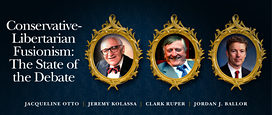Jeremy Kolassa has rightly identified a central difficulty with the modern liberal order: we don’t agree on what the “good” is. From this the question of authority follows: “who decides what we ought to do?” I have highlighted some ways in which an Augustinian sensibility might inform a more limited vision of compatibility between conservatives and libertarians as focused on matters related to temporal peace.
We must then ask how we adjudicate questions of what practically promotes such peace. A significant and fundamental distinction needs to be made on this score concerning the relationship between legality and morality. By this I mean that we ought to properly understand how the realm of positive law fits within the larger structure of morality.
This distinction correlates with my earlier claims about the limitations inherent in libertarianism when conceived as a political philosophy as opposed to a world-and-life view. For instance, the non-aggression principle (NAP) may well be an important principle of political economy, but it hardly suffices as a principle for morality qua morality. A kind of Hippocratic Oath for policy (“first do no harm”) can be an important principle for governing, but it doesn’t get adequately at the positive obligations that we have towards other people on an individual (and even communal) level.
In this way, the context that Thomas Aquinas provides for distinguishing between morality and legality is quite helpful in determining when to make law and even what kinds of law to make. In addressing the question, “Whether it belongs to human law to repress all vices?” Aquinas answers negatively. He accepts that positive law has a pedagogical function, but also recognizes the limitations inherent in a finite and fallen humanity. Thus he writes, “laws imposed on men should also be in keeping with their condition.” This is the nature of positive law, in fact, as a mutable expression and reflection of the natural law. In this way, “human law is framed for a number of human beings, the majority of whom are not perfect in virtue. Wherefore human laws do not forbid all vices, from which the virtuous abstain, but only the more grievous vices, from which it is possible for the majority to abstain; and chiefly those that are to the hurt of others, without the prohibition of which human society could not be maintained: thus human law prohibits murder, theft and such like.”
Addressing the question of the law’s pedagogical function, which many libertarians are loathe to acknowledge, Aquinas limits the applicability of this purpose: “The purpose of human law is to lead men to virtue, not suddenly, but gradually. Wherefore it does not lay upon the multitude of imperfect men the burdens of those who are already virtuous, viz. that they should abstain from all evil.” He goes on to provide a kind of prudential rule for how to determine what laws are good and bad. Some laws, he says, try to restrain vices that are beyond the ability of people to bear, and thus “the precepts are despised, and those men, from contempt, break into evils worse still.”
The payoff of all this is that Aquinas distinguishes morality and legality in a way that can helpfully inform conservative understandings of the purpose of law. That is, to permit something legally is not the same as acknowledging it as morally permissible. Legal toleration is not the same as moral approbation. For libertarians, however, this distinction should also inform an understanding of the gradation between legal toleration and legal promotion. For Aquinas, and much of the classical tradition, the legal order has no warrant for actively promoting or subsidizing vice, even in cases where it might be merely tolerated or not legally proscribed.
It seems to me that much of what is often distinctive of libertarian political activism falls into this category. A particularly notable example might be the work by many libertarians to have same-sex partnerships recognized as “marriage” under an argument for equal treatment. As Clark Ruper writes, this kind of advocacy is deeply progressive: “modern liberals and libertarians today still share that same valuation of the individual in society. This is most easily seen today in the issue of marriage equality, where social conservatives try to use the power of the state to control marriage because it is an important social institution, while liberals and libertarians focus on the importance of marriage in the lives of all individuals.” Alternatively, many libertarians are arguing that government should get out of the business of defining or recognizing marriage altogether. However, a strong case can be made for recognizing the significance of civil social institutions, most particularly the family, such as argued by Sherif Girgis, Robert P. George, and Ryan T. Anderson that “marriage privatization would be a catastrophe for limited government.”
An understanding of the distinction between morality and legality would thus help identify places where libertarians and conservatives might practically work together, while informing their respective understandings of the purpose and limits of law. Conservatives and libertarians ought to recognize that positive law is not meant to repress all vices or to promote all virtues. Its scope is far more limited, and rightly so. This gives us some hope and some guidance for how a temporally focused and practically limited fusionist agenda might be advanced.

